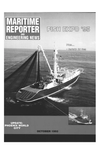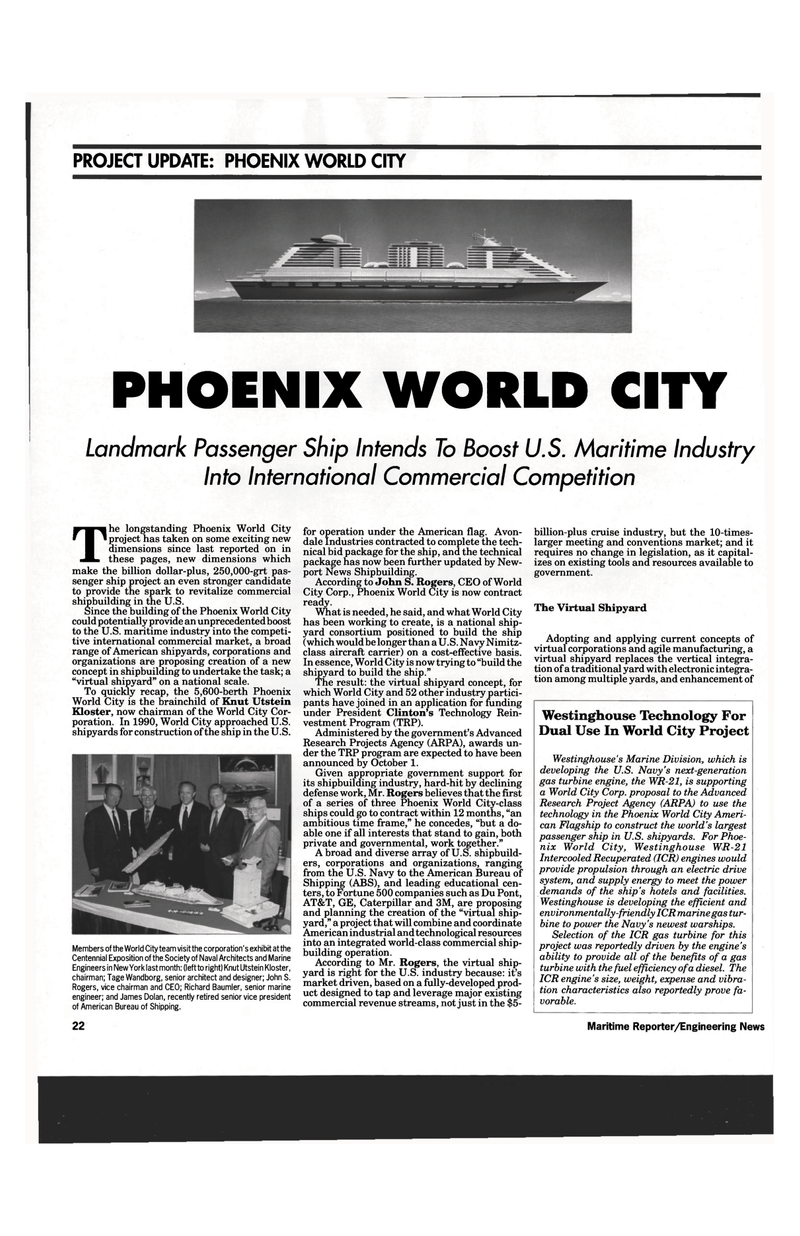
Page 20: of Maritime Reporter Magazine (October 1993)
Read this page in Pdf, Flash or Html5 edition of October 1993 Maritime Reporter Magazine
PROJECT UPDATE: PHOENIX WORLD CITY
PHOENIX WORLD CITY
Landmark Passenger Ship Intends To Boost U.S. Maritime Industry
Into International Commercial Competition
The longstanding Phoenix World City project has taken on some exciting new dimensions since last reported on in these pages, new dimensions which make the billion dollar-plus, 250,000-grt pas- senger ship project an even stronger candidate to provide the spark to revitalize commercial shipbuilding in the U.S.
Since the building of the Phoenix World City could potentially provide an unprecedented boost to the U.S. maritime industry into the competi- tive international commercial market, a broad range of American shipyards, corporations and organizations are proposing creation of a new concept in shipbuilding to undertake the task; a "virtual shipyard" on a national scale.
To quickly recap, the 5,600-berth Phoenix
World City is the brainchild of Knut Utstein
Kloster, now chairman of the World City Cor- poration. In 1990, World City approached U.S. shipyards for construction of the ship in the U.S.
Members of the World City team visit the corporation's exhibit at the
Centennial Exposition of the Society of Naval Architects and Marine
Engineers in New York last month: (left to right) Knut Utstein Kloster, chairman; Tage Wandborg, senior architect and designer; John S.
Rogers, vice chairman and CEO; Richard Baumler, senior marine engineer; and James Dolan, recently retired senior vice president of American Bureau of Shipping. 22 for operation under the American flag. Avon- dale Industries contracted to complete the tech- nical bid package for the ship, and the technical package has now been further updated by New- port News Shipbuilding.
According to John S. Rogers, CEO of World
City Corp., Phoenix World City is now contract ready.
What is needed, he said, and what World City has been working to create, is a national ship- yard consortium positioned to build the ship (which would be longer than a U.S. Navy Nimitz- class aircraft carrier) on a cost-effective basis.
In essence, World City is now trying to "build the shipyard to build the ship."
The result: the virtual shipyard concept, for which World City and 52 other industry partici- pants have joined in an application for funding under President Clinton's Technology Rein- vestment Program (TRP).
Administered by the government's Advanced
Research Projects Agency (ARPA), awards un- der the TRP program are expected to have been announced by October 1.
Given appropriate government support for its shipbuilding industry, hard-hit by declining defense work, Mr. Rogers believes that the first of a series of three Phoenix World City-class ships could go to contract within 12 months, "an ambitious time frame," he concedes, "but a do- able one if all interests that stand to gain, both private and governmental, work together."
A broad and diverse array of U.S. shipbuild- ers, corporations and organizations, ranging from the U.S. Navy to the American Bureau of
Shipping (ABS), and leading educational cen- ters, to Fortune 500 companies such as Du Pont,
AT&T, GE, Caterpillar and 3M, are proposing and planning the creation of the "virtual ship- yard," a project that will combine and coordinate
American industrial and technological resources into an integrated world-class commercial ship- building operation.
According to Mr. Rogers, the virtual ship- yard is right for the U.S. industry because: it's market driven, based on a fully-developed prod- uct designed to tap and leverage major existing commercial revenue streams, not just in the $5- billion-plus cruise industry, but the 10-times- larger meeting and conventions market; and it requires no change in legislation, as it capital- izes on existing tools and resources available to government.
The Virtual Shipyard
Adopting and applying current concepts of virtual corporations and agile manufacturing, a virtual shipyard replaces the vertical integra- tion of a traditional yard with electronic integra- tion among multiple yards, and enhancement of
Westinghouse Technology For
Dual Use In World City Project
Westinghouse's Marine Division, which is developing the U.S. Navy's next-generation gas turbine engine, the WR-21, is supporting a World City Corp. proposal to the Advanced
Research Project Agency (ARPA) to use the technology in the Phoenix World City Ameri- can Flagship to construct the world's largest passenger ship in U.S. shipyards. For Phoe- nix World City, Westinghouse WR-21
Intercooled Recuperated (ICR) engines would provide propulsion through an electric drive system, and supply energy to meet the power demands of the ship's hotels and facilities.
Westinghouse is developing the efficient and environmentally-friendly ICR marine gas tur- bine to power the Navy's newest warships.
Selection of the ICR gas turbine for this project was reportedly driven by the engine's ability to provide all of the benefits of a gas turbine with the fuel efficiency of a diesel. The
ICR engine's size, weight, expense and vibra- tion characteristics also reportedly prove fa- vorable.
Maritime Reporter/Engineering News

 19
19

 21
21
